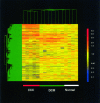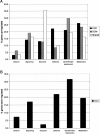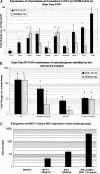Cardiac gene expression profiling provides evidence for cytokinopathy as a molecular mechanism in Chagas' disease cardiomyopathy
- PMID: 16049318
- PMCID: PMC1603558
- DOI: 10.1016/S0002-9440(10)62976-8
Cardiac gene expression profiling provides evidence for cytokinopathy as a molecular mechanism in Chagas' disease cardiomyopathy
Abstract
Chronic Chagas' disease cardiomyopathy is a leading cause of congestive heart failure in Latin America, affecting more than 3 million people. Chagas' cardiomyopathy is more aggressive than other cardiomyopathies, but little is known of the molecular mechanisms responsible for its severity. We characterized gene expression profiles of human Chagas' cardiomyopathy and dilated cardiomyopathy to identify selective disease pathways and potential therapeutic targets. Both our customized cDNA microarray (Cardiochip) and real-time reverse transcriptase-polymerase chain reaction analysis showed that immune response, lipid metabolism, and mitochondrial oxidative phosphorylation genes were selectively up-regulated in myocardial tissue of the tested Chagas' cardiomyopathy patients. Interferon (IFN)-gamma-inducible genes represented 15% of genes specifically up-regulated in Chagas' cardiomyopathy myocardial tissue, indicating the importance of IFN-gamma signaling. To assess whether IFN-gamma can directly modulate cardio-myocyte gene expression, we exposed fetal murine cardiomyocytes to IFN-gamma and the IFN-gamma-inducible chemokine monocyte chemoattractant protein-1. Atrial natriuretic factor expression increased 15-fold in response to IFN-gamma whereas combined IFN-gamma and monocyte chemoattractant protein-1 increased atrial natriuretic factor expression 400-fold. Our results suggest IFN-gamma and chemokine signaling may directly up-regulate cardiomyocyte expression of genes involved in pathological hypertrophy, which may lead to heart failure. IFN-gamma and other cytokine pathways may thus be novel therapeutic targets in Chagas' cardiomyopathy.
Figures




References
-
- WHO Expert Committee: Control of Chagas’ disease. World Health Org Tech Rep 2002, 905:i - PubMed
-
- Bestetti RB, Muccillo G. Clinical course of Chagas’ heart disease: a comparison with dilated cardiomyopathy. Int J Cardiol. 1997;60:187–193. - PubMed
-
- Martinelli FM, De Siqueira SF, Moreira H, Fagundes A, Pedrosa A, Nishioka SD, Costa R, Scanavacca M, D’Avila A, Sosa E. Probability of occurrence of life-threatening ventricular arrhythmias in Chagas’ disease versus non-Chagas’ disease. Pacing Clin Electrophysiol. 2000;23:1944–1946. - PubMed
-
- Higuchi ML, De Morais CF, Pereira Barreto AC, Lopes EA, Stolf N, Bellotti G, Pileggi F. The role of active myocarditis in the development of heart failure in chronic Chagas’ disease: a study based on endomyocardial biopsies. Clin Cardiol. 1987;10:665–670. - PubMed
-
- Kawai C, Matsumori A, Fujiwara H. Myocarditis and dilated cardiomyopathy. Annu Rev Med. 1987;38:221–239. - PubMed
Publication types
MeSH terms
Substances
Grants and funding
LinkOut - more resources
Full Text Sources
Other Literature Sources
Research Materials

